CADC Storage Inventory Architecture and Deployment
Introduction
Storage Inventory Terms and Concepts
artifact
A representation of a file and its metadata in the SI database, specifically the inventory.Artifact table (see the SI data model). The term artifact is often used to refer to both the database representation of a file and the file itself as one thing, but when an SI application is acting on an artifact, it specifically refers to the database.
- ➡️ an artifact URI is a unique idenitfier for a file (or object) stored in SI. The last path component of a URI is always the filename.
bucket
SI assigns a bucket label to files on storage and to artifacts in the inventory database.
- Some SI applications can work on subsets of buckets, allowing some degree of parallelization.
- Buckets labels are represented by hex strings, e.g.
a74. - Although the bucket label of a file can also refer to the location of the file on storage, the two are not necessarily related. On a storage platform that uses the concept of buckets (e.g. Swift), a file's bucket label is currently used as part of the storage platform's bucket, but this is just an optimization; on a POSIX file-system, the bucket will be parsed into subdirectories (e.g. /a/7/4/).
- When applications refer to buckets in the inventory database, they are refering to the inventory.Artifact.uriBucket column in the database. This column is populated with a random hex string on artifact creation.
- ❗ storage buckets and uri buckets are not the same thing, e.g. files in storage bucket
04care not necessarily the same as artifacts in uri bucket04c.
namespace
A namespace is an SI identifier for a collection of artifacts, and can be used to define the logical structure of data within SI. For example, cadc:CFHT/ might be used to identify all CFHT files held at the CADC; cadc:CFHT/raw/ might be used to identify all of the raw CFHT files held at the CADC -- both cadc:CFHT/ and cadc:CFHT/raw/ are namespaces but they identify different scopes of CFHT artifacts. SI services and applications often act on namespaces defined using regex patterns -- such as during file replication and determining access permissions -- so some thought must be put into what is used. See the SI data model page for more detail on the concepts of URI and namespace.
- A namespaces is defined part of an artifact URI that ends in
:or/.- ❗A namespace must always end at a delimiter to avoid confusion with other namespaces (e.g. cadc:TEST and cadc:TESTDATA, instead of cadc:TEST/ and cadc:TESTDATA/).
- the URI for an artifact is 'namespace/filepath'. A namespace which includes an artifact can include any delimited path defined by the artifact's URI, e.g. all of the following are namespaces which include the artifact
cadc:TEST/data/raw/example/test1.fits:cadc:cadc:TEST/cadc:TEST/data/cadc:TEST/data/raw/cadc:TEST/data/raw/example/
- ❗ A URI which has a filepath of just the filename (e.g.
cadc:test1.fits) is not recommended.- It is possible to have files with the same name, as long as they are in different namespaces.
- The part of the namespace preceding the
:is referred to as the 'scheme' elsewhere in the documentation. This part of the namespace usually refers to an organization (e.g.cadc:DAO,mast:JWST)
resourceID
This is an unique ID for a deployed service. A registry service provides a look-up to translate these IDs into service URLs. Example: ivo://opencadc.org/minoc, which might resolve to https://www.opencadc.org/minoc.
- a
resourceIDis a label which identifies a service in an abstract way.- ➡️ Service locations could change, but resourceIDs should not.
resourceIDsmay be shared within a site -- used by local services and applications -- but may also be shared across an organization. Because the scope of a site's resourceIDs could be broad, some thought needs to be put into their definition.- the
ivo:scheme in theresourceIDmeans that theregistryservice that will be used to resolve theresourceIDcomplies with the IVOA registry standard. The available CADCregservice is an example of an IVOA registry implementation.
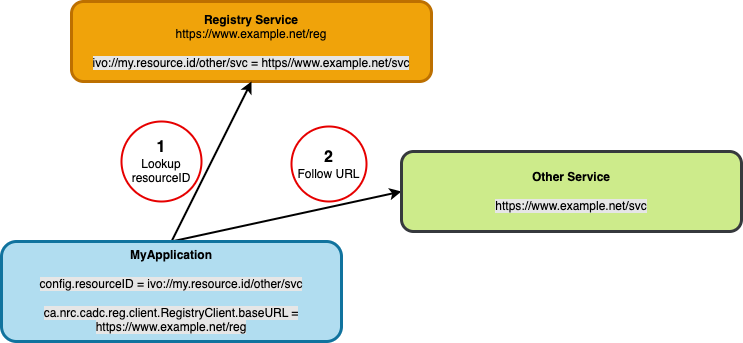
Storage Inventory Resources
Container Image Repository
- URL: https://images.opencadc.org
- This is an OCI compliant image repository, so images can be downloaded using the standard URL format:
https://images.opencadc.org/<project>/<image>:<tag>, where the list of projects, images, and tags can be found using the commands below. Images specific to Storage Inventory will be found in thestorage-inventoryproject, although images for supporting services may be in other projects (i.e. incore). - To see what projects are hosted here, use (
jqis a helpful command for parsing JSON):
curl -s https://images.opencadc.org/api/v2.0/projects | jq '[.[].name] | sort'
- To see what images are available in a project, use (e.g., for storage-inventory):
curl -s https://images.opencadc.org/api/v2.0/projects/storage-inventory/repositories | jq '[.[].name] | sort'
- To see what version tags are available for an image, use (e.g., for storage-inventory/minoc):
curl -s https://images.opencadc.org/api/v2.0/projects/storage-inventory/repositories/minoc/artifacts | jq '[.[].tags | select (. != null) | .[].name] | sort'
- A note on image tags:
- image tags will look like version (e.g.
0.9.0) or version-datetimestamp (e.g.0.9.0-20230217T201656) - The datetimestamp is a build identifier -- the image with the a plain version number (0.9.0 in the example given) will be the same image as the image with the same version number and the latest build identifier.
- for a version of
x.y.z:xwill change with major releases -- functionality, api, and configuration may change and break earlier configuration.ywill change with minor releases -- minor non-breaking or backwards-compatible feature or configuration changes.zwill change with minor bug fixes -- otherwise compatible with current version features and configuration.
- image tags will look like version (e.g.
Other Documents
Overview of Storage Inventory
System Architecture
Storage Inventory consists of the components that make up one or more Storage sites and a Global site. A Storage site can exist on its own, as a mechanism for maintaining a structured inventory of files. A Global site is required when there are two or more Storage sites which need to be synchronized; it also provides a single site for users to go to find all available copies of a file. A detailed description of the data model, features and limitations can be found here.
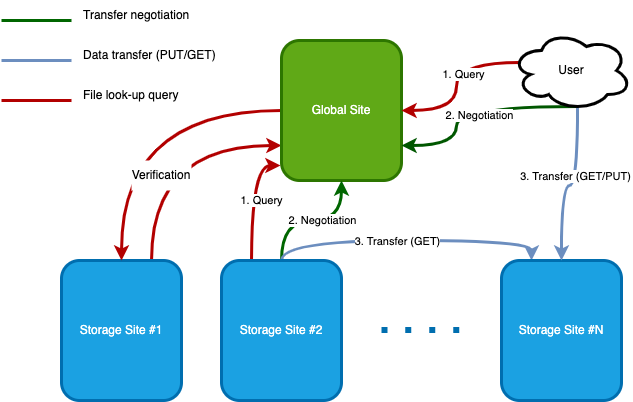
In general:
- A Storage site is never configured to have knowledge of another Storage site.
- A Storage site discovers artifacts which it should have by querying the Global site. The Storage site then uses the artifact metadata (specifically the artifact URI) to query the Global site for URLs to the files corresponding to those artifacts and downloads them.
- A Storage site will validate the contents of its physical storage against the contents of the inventory database.
- A Global site queries each Storage site for files that they have, and files that have been removed, so it maintains a unified global record of all artifacts within a Storage Inventory deployment.
Standalone Storage Site
A Storage site maintains an inventory of the files stored at a particular location, and provides mechanisms to access (minoc) those files and query (luskan) the local inventory. Below is an outline of a stand-alone (no Global site) Storage Inventory Storage site, with one storage system, one database, etc, in one data centre. If you have files in multiple data centres, or more than one storage platform in one data centre (e.g. some files on a posix file-system and some on Ceph object storage), you would have more than one Storage site, and each site would run its own services, database, storage, and applications.
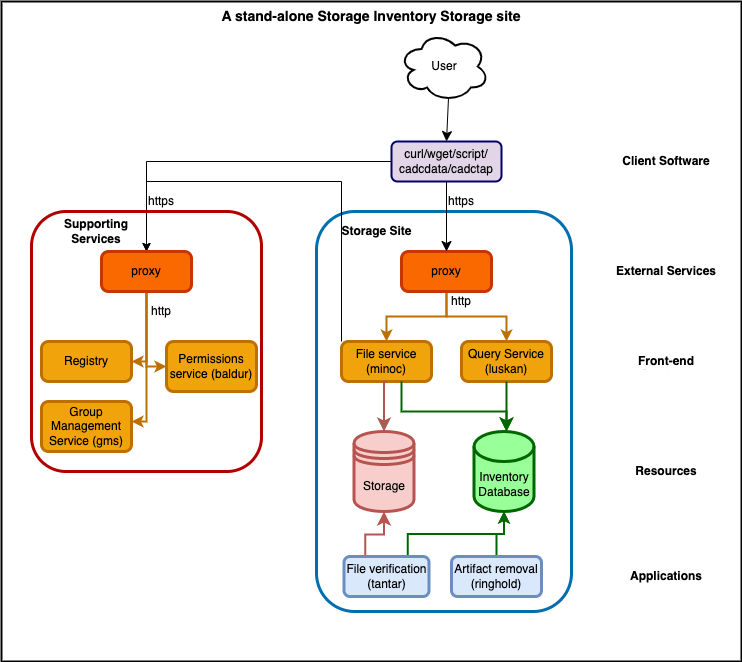
A standalone Storage Inventory Storage site will consist of following:
- Front-end Web services:
- A File service (
minoc): provides a REST based file service that supports HEAD, GET, PUT, POST, DELETE operations. - A Query service (
luskan): provides a Web Service for querying artifact metadata contained in the Inventory database, using theIVOA Table Access Protocol(TODO: Replace TAP link with user document, not reference to spec....)
- A File service (
- Resources:
- An Inventory database: this is the ledger tracking all the files storage at the site. Applications and services will access this database in parallel so it will need to have good performance, especially as the content at the site grows. Currently only Postgresql is supported.
- A Storage platform: the storage platform on which file will be stored. Currently, SI supports two types of storage: POSIX-compliant file-systems (e.g. Lustre) and Swift API compatible Object Store (e.g. Ceph Object Store)
- SI services and applications interact with the back-end storage using a Storage Adapter:
- Applications:
- A File validation application (
tantar): Artifact validation application that compares the inventory database with the contents of the back-end storage. - An artifact removal tool (
ringhold): Removes the local copy of artifacts. Use with caution: essentially the same as\rm -ron a namespace at a storage site.
- A File validation application (
- Supporting Infrastructure and Services:
- A proxy/ingress service: All the calls the front-end Web services need to go through a proxy/ingress that provides SSL termination and ensures that authentication headers are correctly set before being routed to the actual service. The proxy needs a public IP address and a valid SSL certificate (e.g. Let's Encrypt). This proxy service might be an external load balancer (e.g. haproxy) or an ingress in your container orchestration system -- the details will vary depending on your deployment environment. Whichever proxy or ingress is chosen, it must support x509 client proxy certificates.
- ➡️ Note: although the diagram above shows a separate proxy for Storage site services and supporting services, this might not be necessary on all infrastructure.
- A
Registryservice: Used to map resourceIDs to the actual URLs where the service is deployed. Client software, services, and applications will use a registry to look up the locations of services. The linkedcadc-registry-serveris provided as an example implementation. - A Permissions services (
baldur): permissions service which uses configurable rules to grant access based on resource identifiers (Artifact.uri values or namespaces). This service is required if Authentication and Authorization (A&A) is required for the SI deployment. Generally, baldur works along with a Group Membership Service (GMS) and/or User Service. - A Group Membership Service (
GMS): . Needed for providing the IVAO group membership look-up API used bybaldurand other services when determining access permissions. For an example implementation, built on top of Indigio IAM, see https://gitlab.com/ska-telescope/src/group-membership-service (more implementation details to follow).
- A proxy/ingress service: All the calls the front-end Web services need to go through a proxy/ingress that provides SSL termination and ensures that authentication headers are correctly set before being routed to the actual service. The proxy needs a public IP address and a valid SSL certificate (e.g. Let's Encrypt). This proxy service might be an external load balancer (e.g. haproxy) or an ingress in your container orchestration system -- the details will vary depending on your deployment environment. Whichever proxy or ingress is chosen, it must support x509 client proxy certificates.
Global Site with Multiple Storage Sites
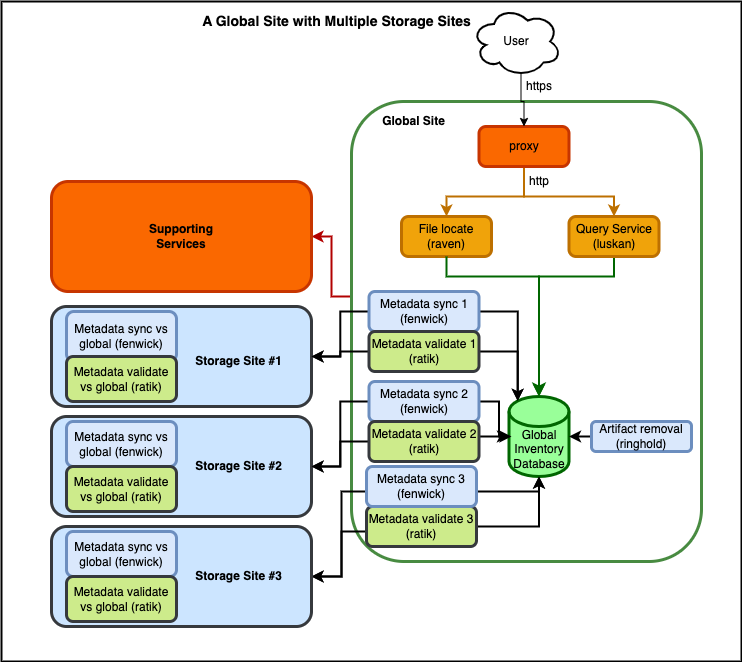
If you need to replicate files among multiple Storage Sites, you will need a Global Site. The Global site maintains a view of all Storage sites, allowing individual Storage sites to discover files that they need to copy. This also provides a single site which users can query to find files, rather than having to know about and search individual Storage sites.
A Global site will be required different services than a Storage site, and both Storage sites and Global sites will need to run additional applications to synchronize metadata and files.
- Front-end Web services:
- Resources:
- An Global Inventory database: this is basically identical to a Storage site inventory database, except there is additional information regarding where each file is located.
- ➡️ A Global site does not require file storage.
- Applications:
- both Storage sites and Global site will need a Metadata synchronization application (fenwick) -- a Storage site will only need to run one instance of
fenwickbut a Global site will need to run an instance offenwickfor each Storage site it needs to track. See the Metadata synchronization description below. - both sites will also need to periodically run a Metadata validation application (ratik) -- similar to
fenwicka Storage site will only need to run one instance ofratikbut a Global site will run an instance ofratikfor each Storage site it is tracking. - a File synchronization application (critwall) -- only Storage sites will need to run this application. It will query the local inventory database for artifacts which do not have assocated files in local storage, query the Global
ravenservice for the locations of those files, and download them to the local storage. See the File synchronization description below.
- both Storage sites and Global site will need a Metadata synchronization application (fenwick) -- a Storage site will only need to run one instance of
Metadata synchronization
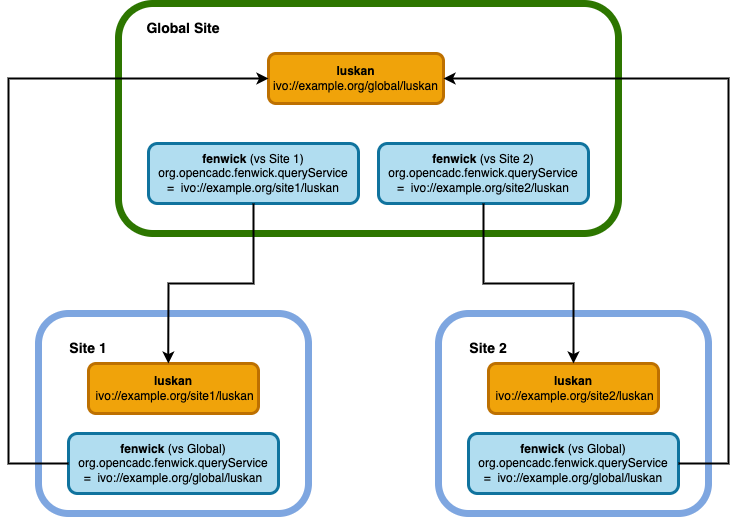
File synchronization
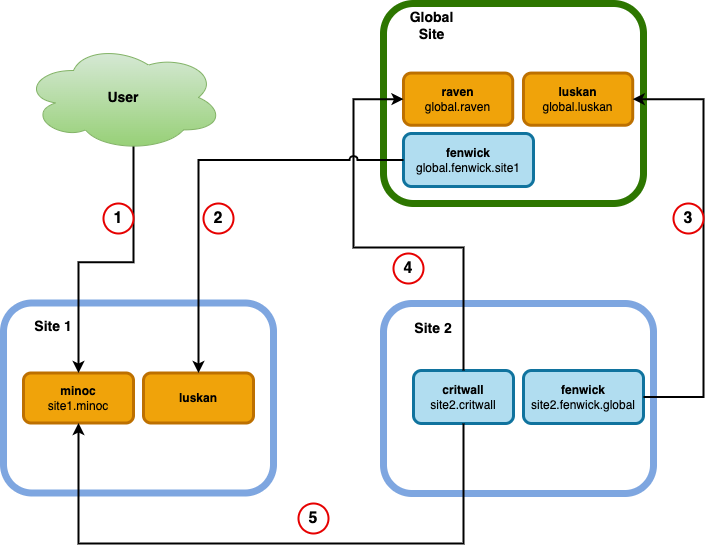
- User PUTs a file to the
site1.minocservice, either directly or via negotiation with a globalravenservice. global.fenwick.site1discovers the new inventory metadata for the file by queryingsite1.luskan.site2.fenwick.globaldiscovers the new inventory metadata for the file by queryingglobal.luskan.site2.critwallfinds the locations of the new file viaglobal.raven-- this returns a list of URLs from which the file can be downloaded.site2.critwalldownloads the file fromsite1.minoc.
Client Software
Generic HTTP client tools such as curl or wget can be used to interact with the SI, however multi-step operations such as transfer negotiations or transfer of large files with
SI transactions might require dedicated scripts. (TODO provide examples of usage)
Alternatively, the CADC maintains Python client applications/libraries that can be used with the SI:
cadcdata- for file operations with minoc and raven. That includes transfer negotiations, file uploads, downloads or deletes. Or simply file information. The package takes advantage of the SI features to offer robust and fault tollerant transfer of files small or large.cadctap- for querying the artifact metadata. It works with a luskan service delopyed at a site or the global one. Alternatively, any generic TAP-based tool can be used to query luskan including (but not limitted to)PyVO
The CADC Direct Data Service presents a variety of scenarios for accessing the CADC SI using generic and specific client tools.
Deployment Prerequisites
Hardware Requirements
Database:
- Required for: Storage site and Global site
- storage: about 1KB/artifact (storage site) or 1.5KB/artifact (global site) for data and indices.
- RAM/CPU: For a site with 200 million artifacts, 20 cores with 180GB RAM and NVMe storage gives sufficient performance.
- PG 12.3 or newer
Storage platform:
-
Required for: Storage site only
-
Ceph Object store (version 14 or greater)
OR
-
POSIX file-system.
Worker nodes:
- SI applications and services don't consume a lot of memory (~1GB-4GB per instance) although some (minoc, critwall) are multithreaded and can take advantage of multiple cores.
- In a production setting it would be best not to mix services and applications on the same nodes in order to ensure that service quality isn't affected by things like metadata validation. A single node might suffice in a test deployment whereas you'll need several nodes for a production deployment.
Software Requirements
- container images are all OCI-compliant (produced with docker cli), so should run in any compatible environment.
- orchestration software: A simple, single node test deployment example will be provided. Deployment within different orchestration environments (e.g. Docker Swarm, Kubernetes) are beyond the scope of this document (maybe we can provide helm charts eventually...?)
haveged(or other entropy-generating service) this is only necessary on hosts running the services.
Deployment
Note on logging: Storage inventory services and application containers all log to stdout by default -- for a production deployment, these should be captured and preserved by whatever mechanism is available on your system.
-
- Required for: Storage site only
- Required by: critwall, minoc, and tantar
- How to configure your storage is dependent upon your local hardware and data centre details. However --
- Currently, there are two types of storage supported, each of which requires a storage adapter and associated configuration files:
- POSIX file-system
-
for POSIX storage, the storage file-system will need to be mounted directly into the containers (e.g. a 'volume' path in Docker or a PVC in kubernetes). Since the storage will be mounted by several containers, it will need to be a shared file-system which supports writes from multiple hosts.
-
❗NOTE: the services in the containers run as a user with a UID:GID of 8675309:8675309. This user must be allowed to read and write files on the configured file-system. This is usually done by ensuring a non-privileged (or even 'nologin') user is configured on your system with this UID:GID.
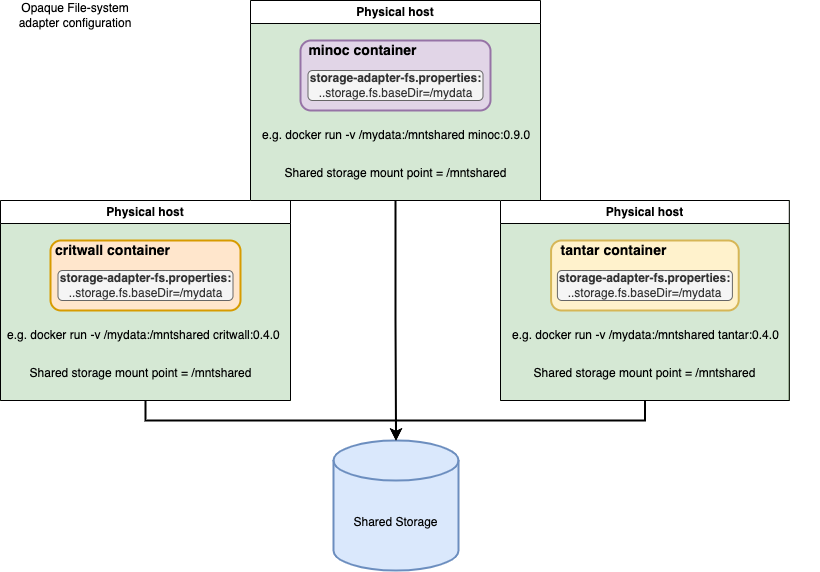
-
in the
cadc-storage-adapter-fs.propertiesconfiguration file for POSIX storage :- the
org.opencadc.inventory.storage.fs.baseDirparameter must point to the location that the storage is mounted inside the container. For example,
ordocker run --user tomcat:tomcat -v /path/on/host:/mountpoint/in/container minoc:0.9.2apiVersion: app/v1 kind: deployment <...snip....> volumeMounts: - mountPath: "/mountpoint/in/container" name: lustre-volume securityContext: runAsUser: 8675309 runAsGroup: 8676309 volumes: - name: lustre-ceph-volume hostPath: path: /path/on/host type: Directory - the
org.opencadc.inventory.storage.fs.OpaqueFileSystemStorageAdapter.bucketLengthsets the depth of the directory tree created to store files. At each node in the tree, 16 hex (0-f) directories are created -- abucketLengthof 2 will create 16 directories (0-f) each with sixteen subdirectories (0-f) -- only the 256 (16x16) subdirectories at the bottom of the tree will be used to store files. For efficiency of validation, you should choose abucketLengthwhich results in only a few thousand files in each directory. e.g, for abucketLength=3andbaseDir = /mount/in/container:[container]$ ls -F /mount/in/container/ 0/ 1/ 2/ 3/ 4/ 5/ 6/ 7/ 8/ 9/ a/ b/ c/ d/ e/ f/ # Depth=1/3 [container]$ ls -F /mount/in/container/a/ 0/ 1/ 2/ 3/ 4/ 5/ 6/ 7/ 8/ 9/ a/ b/ c/ d/ e/ f/ # Depth=2/3 [container]$ ls -F /mount/in/container/a/7/ 0/ 1/ 2/ 3/ 4/ 5/ 6/ 7/ 8/ 9/ a/ b/ c/ d/ e/ f/ # Depth=3/3 [container]$ ls -F /mount/in/container/a/7/4/ test0001.fits test0002.fits test0003.fits test0004.fits test0005.fits - in the above example the 'bucket' is the directory path:
a74, and there will be a total of 4096 (16x16x16) buckets. - Note: as you can see, the currently implemented version of this storage adapter is the 'OpaqueFileSystem' adapter -- the structure of subdirectories is not something which can easily be mounted and used elsewhere. It would be possible to develop a filesystem adapter which provides a human readable directory structure.
- the
-
- Swift Object Store API (e.g. CEPH Object Store)
- for Swift storage, the Ceph gateway URL must be reachable from inside the containers.
- in the
cadc-storage-adapter-swift.propertiesconfiguration file for Swift storage:org.opencadc.inventory.storage.swift.SwiftStorageAdapter.bucketLengthsets the number of hex characters in the configured buckets (e.g.a74), and the total number of buckets (i.e. abucketLengthof 3 will create 16^3 (4096) buckets). Configure thebucketLengthso the expected number of files per bucket is no more than a few thousand.
- POSIX file-system
- Currently, there are two types of storage supported, each of which requires a storage adapter and associated configuration files:
- Whichever storage you use, it must be directly available to certain Storage Inventory services and applications. These are:
- minoc -- this service will write files to and retrieve files from storage.
- critwall -- only required in a Storage Inventory deployment with more than one Storage site and a Global site. This application will scan the site inventory database for artifacts with metadata but no associated local file copy in storage, then negotiate the transfer of those files with the Global site raven service.
- tantar -- this application verifies the content of the storage system against the inventory database, so will need to read files from the storage.
-
- Required for: Storage site and Global site
- Required by: critwall, fenwick, luskan, minoc, ratik, raven, ringhold, tantar
- The database will be accessed by all local SI site services and applications, so must be reachable from wherever you deploy your containers for that site.
- Storage Inventory services have been tested with postgres 12.3. Newer versions will likely work as well.
- As the content in the database grows, you'll need to think about its storage requirements. For the PG data and indices, this is roughly 1KB/artifact (storage site) or 1.5KB/artifact (global site)
-
In the following, the database being created is called
si_db, but you can change that name as you see fit. Whatever you choose, it will need to be referenced in the service and application configuration.- Initialize the database:
initdb -D /var/lib/postgresql/data --encoding=UTF8 --lc-collate=C --lc-ctype=C - You might need to change the data location (
-D), depending on your postgres installation and hardware layout.
- Initialize the database:
-
As the postgres user, create a file named si.dll with the linked content, edit as appropriate, and run
psql -f si.dll -a- This will create three users:
- A TAP admin user (e.g.
tapadm) - privileged user. Manages the tap schema with permissions to create, alter, and drop tables. Used by:- luskan
- A User TAP query user (e.g.
tapuser) - unprivileged user. Used by theluskanservice to query the inventory database. Used by:- luskan
- raven
- An Inventory admin user (e.g.
invadm) - privileged user. Manages the inventory schema with privileges to create, alter, and drop tables, and is also used to insert, update, and delete rows in the inventory tables. Used by:- critwall
- fenwick
- minoc
- ratik
- ringhold
- tantar
- A TAP admin user (e.g.
- This will create three users:
- ❗ NOTE: The first service or application configured with the Inventory admin user to connect to the database will create and initialize the tables and indices using the above privileged user roles.
- a basic example of a developer deployment of a compatible database can be found in here. (Except pgsphere is not required...)
-
- Required for: Storage site and Global site
- ❗x509 proxy certificates -- the longer certificate chain for these might not be supported by all balancers/proxies. These proxy certificates are required for some A&A mechanisms.
- haproxy
- haproxy will need to be compiled against
openssl 1.0.2kor a compatible version. Newer versions ofopenssldo not support proxy certificates. - the environment variable
OPENSSL_ALLOW_PROXY_CERTS=1needs to be set in the proxy environment. - a basic example of a developer deployment of a compatible instance of haproxy can be found here and here.
- haproxy will need to be compiled against
- nginx
- untested, but likely has the same requirements and restrictions as haproxy for proxy certificates.
- haproxy
- SSL termination -- although you will need to support https connections to your proxy, the SI containers do not accept https connections. Because of this, your proxy must terminate the SSL connection and pass only non-SSL http connections to the containers.
- To make a service available under a different name or path than the default, complex proxy rules are not required: see war-rename.conf in the FAQ.
-
- Required for: Storage site and Global site (Note: could be the same registry instance for both)
- Container image: Use the latest
core/regimage fromimages.opencadc.orgor a different IVOA-compatible registry service. - See the opencadc registry server documentation for configuarion details.
resourceIDs- you will need to choose resourceIDs for services and resources that you deploy, and which need to be referenced by other services and applications. For example, if your
minocservice is available at the URLhttps://www.example.org/minocand you choose a resourceID ofivo://example.org/minoc, the registry config for that resource (in thereg-resource-caps.propertiesfile for the registry service) would look like:
This resourceID will appear in, for example, theivo://example.org/minoc = https://www.example.org/minocminoc.propertiesfile in theminocservice config:org.opencadc.minoc.resourceID = ivo://example.org/minoc- you will need to choose resourceIDs for services and resources that you deploy, and which need to be referenced by other services and applications. For example, if your
- test with, e.g.,
curl https://www.example.org/reg/resource-caps
-
baldur - Permission service
- Required for: Storage site and Global site (Note: would likely be the same baldur instance for both)
- Container image: Use the latest
storage-inventory/baldurimage fromimages.opencadc.org - See the opencadc storage inventory baldur documentation for more configuration details.
- Uses an IVOA compatible GMS service and configured namespaces to determine file access permissions.
- Configuration notes:
baldur.properties:- The
org.opencadc.baldur.allowedUserx509 DN specified here is generally a 'service' user -- the services that callbaldurneed to be configured with this user's certificate.- in
minocandravenconiguration, this is thecadcproxy.pemfile for these services.
- in
- The
org.opencadc.baldur.allowedGroupis an IVOA GMS group resourceID.- The GMS service must be registered in the available Registry service.
- the configured
readOnlyGroupandreadWriteGroupentries are also IVOA GMS group resourceIDs.
- The
- test with, e.g.,
curl https://www.example.org/baldur/availability
-
GMS - Group Membership service
- Required for: Storage site and Global site (Note: could be the same gms instance for both)
- TBD. See the deployment and build documentation for this implementation built on top of Indigio IAM: https://gitlab.com/ska-telescope/src/group-membership-service
-
minoc - File service
- Required for: Storage site only
- Container image: Use the latest
storage-inventory/minocimage fromimages.opencadc.org - See the opencadc storage inventory minoc documentation for details.
- Configuation notes:
minoc.properties:org.opencadc.minoc.resourceID:- this is the resourceID of this instance of minoc, and will need to be configured in your registry. It is used by the Global inventory as the location for artifacts at a site.
- if you are using a baldur service to manage file access permissions, you would put its resourceID in
org.opencadc.minoc.readGrantProviderandorg.opencadc.minoc.readGrantProvider. It is possible to have multiple instances of these providers, by specifing theGrantProvideroptions for each provider (each use of the option is additive to the previous ones). org.opencadc.minoc.publicKeyFile:- (optional) this is the public key specified in the raven configuration key
org.opencadc.raven.publicKeyFile.
- (optional) this is the public key specified in the raven configuration key
catalina.properties(from cadc-tomcat config):- the
org.opencadc.minoc.inventory.usernamedatabase account is the 'Inventory admin user' configured when creating the database
- the
- when configuring the storage adapter for minoc to use (see Storage above) be sure to test that the containers deployed on your system can access the provided storage.
- test with, e.g.,
curl https://www.example.org/minoc/availability
-
luskan - Query service
- Required for: Storage site and Global site
- Container image: Use the latest
storage-inventory/luskanimage fromimages.opencadc.org - See the opencadc storage inventory luskan documentation for details.
- Configuration notes:
luskan.properties:org.opencadc.luskan.isStorageSite- for a storage site, this should be set totrue. The content of the inventory database is different between a storage site and a global site.org.opencadc.luskan.allowedGroupis an IVOA GMS group resourceID.- the GMS service must be configured in the available Registry service.
catalina.properties:- the
org.opencadc.luskan.uws.usernamedatabase account is generally the same as the 'TAP admin user' configured when creating the database. - the
org.opencadc.luskan.tapadm.usernamedatabase account is the same 'TAP admin user'. - the
org.opencadc.luskan.query.usernamedatabase account is the 'TAP query user' account.
- the
cadc-tap-tmp.properties:- see the cadc-tap-tmp library documentation for more information.
org.opencadc.tap.tmp.TempStorageManager.baseURLis the URL for thisluskanservice, plus a path where query results can be retrieved from.- e.g. if your luskan service is at
https://www.example.org/luskan, then thisbaseURLcould behttps://www.example.org/luskan/results
- e.g. if your luskan service is at
- the above
/resultspath will be mapped to the path in the container specified byorg.opencadc.tap.tmp.TempStorageManager.baseStorageDir. Ideally, this path will be a file-system that is shared among allluskaninstances for your site.- e.g. if
baseStorageDir = /tmpdatain your configuration, the luskan will store query results here (e.g./tmpdata/xyz.xml) and that result will be retrievable ashttps://www.example.org/luskan/results/xyz.xml.
- e.g. if
- test with, e.g.,
curl https://www.example.org/luskan/availability
-
raven - File location service
- Required for: Global site only
- Container image: Use the latest
storage-inventory/ravenimage fromimages.opencadc.org - See the opencadc storage inventory raven documentation for details.
- Configuration notes:
raven.properties- (optional)
org.opencadc.raven.publicKeyFileandorg.opencadc.raven.privateKeyFile:-
These are optional optimizations needed so that raven can generate 'pre-authorized' URLs for files, allowing the minocs that serve the file to skip this step before delivering the file. The authentication information is embedded in a specially encoded URL.
-
these are RSA public and private key files which can be generated using cadc-keygen or the commands below:
ssh-keygen -b 2048 -t rsa -m pkcs8 -f temp_rsa ssh-keygen -e -m pkcs8 -f temp_rsa.pub > raven-public.key mv temp_rsa raven-private.key rm temp_rsa.pub -
the
publicKeyFilewill be required by services which need to verify the pre-authorized URLs (minoc).
-
- (optional)
- See the opencadc storage inventory raven documentation for more configuration details.
- test with, e.g.,
curl https://www.example.org/raven/availability
-
fenwick - Metadata sync application
- Required for: Storage site and Global site
- Container image: Use the latest
storage-inventory/fenwickimage fromimages.opencadc.org - See the opencadc storage inventory fenwick documentation for details.
- Configuration notes:
fenwick.properites:org.opencadc.fenwick.queryService:- fenwick is used to synchronise artifact metadata between a Storage site and a Global site. The
queryServiceis the resourceID for the remoteluskanservice -- ie. if fenwick is running at a Storage site,queryServiceshould refer to the remote Global siteluskan; if fenwick is running at the Global site,queryServiceshould refer to the remote Storage siteluskanservice. A Global site will need to run a fenwick instance for each Storage site.
- fenwick is used to synchronise artifact metadata between a Storage site and a Global site. The
-
tantar - File validation application
- Required for: Storage site only
- Container image: Use the latest
storage-inventory/tantarimage fromimages.opencadc.org - See the opencadc Storage Inventory tantar documentation for details.
- Configuration notes:
tantar.propertiesorg.opencadc.tantar.buckets:- See the description of buckets. Tantar operates on storage buckets.
- If you're only running one instance of tantar it should be configured to operate on all buckets (
0-f); for multiple instances of tantar, you would want to configure these to operate on non-overlapping subsets of buckets (e.g.0-7,8-f).
-
critwall - File sync application
- Required for: Storage site only
- Container image: Use the latest
storage-inventory/critwallimage fromimages.opencadc.org - See the opencadc Storage Inventory critwall documentation for details.
- Configuration notes:
critwall.propertiesorg.opencadc.critwall.locatorService:- This should be configured to point to the resourceID of your Global site instance of
raven.
- This should be configured to point to the resourceID of your Global site instance of
org.opencadc.critwall.buckets:- See the description of buckets. Critwall operates on URI buckets.
- As with tantar, you can run one or more instances of critwall, specifying a single bucket or a range of buckets for each instance.
-
ratik - Metadata validation
- Required for: Storage site and Global site
- Container image: Use the latest
storage-inventory/ratikimage fromimages.opencadc.org - See the opencadc Storage Inventory ratik documentation for details.
- Configuration notes:
ratik.propertiesorg.opencadc.ratik.queryService:- ratik is used to validate the artifact metadata at one site against another site, usually a Storage site vs a Global site or vice versa. The
queryServiceis the resourceID for the remoteluskanservice -- ie. if ratik is running at a Storage site,queryServiceshould refer to the remote Global siteluskan; if ratik is running at the Global site,queryServiceshould refer to the remote Storage siteluskanservice. A Global site will need to run a ratik instance for each Storage site.
- ratik is used to validate the artifact metadata at one site against another site, usually a Storage site vs a Global site or vice versa. The
org.opencadc.ratik.buckets:- See the description of buckets. Ratik operates on URI buckets.
- As with tantar, you can run one or more instances of ratik, specifying a single bucket or a range of buckets for each instance.
Healthchecks and Monitoring
- All Storage Inventory services expose an
/availabilityendpoint which can be used for both monitoring and healthchecks./availability?detail=minreturns no data, but the HTTP return code can be used for an efficient healthcheck.
FAQ
Additional FAQ can be found here
- Database failing to initialize
- I'm sure that my service/application is configured with the correct inventory database url/username/password but it is failing to initialize!
- check that the database pg_hba.conf file allows connections from the host that you're running the service on. If you're running services in a docker swarm or a kubernetes cluster, the egress IP might not be obvious.
- in the service configuration files, check that the configuration keys are correct. For example, the key for the database url for the application fenwick is
org.opencadc.fenwick.inventory.url; the key for the database URL for the service minoc isorg.opencadc.minoc.inventory.url. It is easy to cut and paste between config files and forget to change the key.
- I'm sure that my service/application is configured with the correct inventory database url/username/password but it is failing to initialize!
- How do I remove artifacts and files from a Storage site but not from other Storage sites?
- This might occur if you have multiple storage sites but one storage site runs out of storage space for some reason.
- The correct way to do this is to start with
ratik-- this will remove the artifacts from the site while ensuring that at least one other copy of the artifact exists elsewhere in your Storage Inventory system.- Configure
artifact-selector.sqlforratikandfenwickat the site you wish to remove the artifacts from to exclude their namespace.ratikverifies the local site inventory against the global inventory. If the artifacts are not in the site's 'selector' list, it will remove them from the local site inventory database.fenwicksyncs artifact metadata from the global inventory. If the artifacts are not in the site's 'selector' list, it will not create new local artifacts for them.
- Run
ratikat that site. This will only remove the artifacts from theinventory.Artifacttable in the database. - Configure
org.opencadc.tantar.purgeNamespacefortantarat the site to include the namespace of the artifacts being removed. - Run
tantarat the site. This will remove the files from storage.
- Configure
- The above 'correct' way to remove artifacts from a site can be slow because it will check with the Global site to ensure that copies of the artifact exist elsewhere. If you are confident that there are valid copies elsewhere and you wish to speed up the procedure, do the following at your own risk:
- Configure the
artifact-selector.sqlforratikandfenwickat the site you wish to remove the artifacts from to exclude their namespace.- This still needs to be done to ensure the artifacts aren't synced again on the next run of
ratikorfenwick.
- This still needs to be done to ensure the artifacts aren't synced again on the next run of
- Configure the
artifact-deselector.sqlforringoldat the site to include the artifacts' namespace.ringholdwill explicitly remove the artifacts identified by the 'deselector' WHERE clause from the inventory database.
- Run
ringhold. - Configure
org.opencadc.tantar.purgeNamespacefortantarat the site to include the namespace of the artifacts being removed. - Run
tantarat the site. This will remove the files from storage.
- Configure the
- tantar log interpretation
- tantar is comparing the inventory.Artifact table to the contents of the configured storage system. The
org.opencadc.tantar.policy.ResolutionPolicydetermines whether the storage is definitive ('StorageIsAlwaysRight') or the inventory database is definitive ('InventoryIsAlwaysRight'). Usually, you will be using 'InventoryIsAlwaysRight'. - InventoryIsAlwaysRight.deleteStorageLocation - tantar found a file in storage which didn't match the database, either its checksum didn't match what the artifact insisted it should be (and there was still a file with the matching checksum in storage) or there was no matching artifact in the database. The
reasonfield in the log line gives the rationale for this decision:reason=no-matching-artifact- the file didn't match anything in the database, so should be deleted.reason=old-storageLocation- the file didn't match the storage ID of the artifact, and the correct file with the matching storage ID was available.
- tantar is comparing the inventory.Artifact table to the contents of the configured storage system. The
- Making a service available under a different name -
war-rename.conf- SI services (
baldur,luskan,minoc,raven) expect to be available via a URL like https://example.org/minoc -- i.e. the service name immediately follows the domain name, with a path of '/', and the name of the service in the URL is unchanged.- The services need to know what name and path they are located at in order to be able to issue sensible redirects back to themselves when necessary.
- It is possible to change the name or path to the service at deployment time by putting a config file named
war-rename.confin the service's/configdirectory.- The content of the
war-rename.conffile is a simple Unix shell-like 'mv' command to rename the service war file, e.g. mv minoc.war newname.war - in this example, theminocservice would be available as, e.g., https://example.org/newname. - To add a path element to the name, e.g., to make the service available as https://example.org/site1/minoc instead of https://example.org/minoc, include the path element like so: mv minoc.war site1#minoc.war.
- The content of the
- SI services (